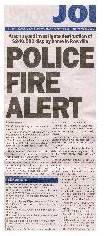| About Claim Solutions... |
 Welcome to the latest edition of Claim Solutions’ Newsletter.
Welcome to the latest edition of Claim Solutions’ Newsletter.
This quarterly publication is aimed to provide you with a claims update including breaking news in relation to insurance claims, interesting and sometimes unusual interpretations of insurance policies and a summary of recent events which may be the subject of insurance claims.
Many fires including a fireworks factory adorn the list of events on page 4 during the last quarter.
Positive feedback indicates our broker friends use this information to highlight to clients that it can happen to you.
With peak renewal time around the corner we hope you or your clients are proactive in the approach to risk management and adequate insurance cover.
We trust this newsletter is useful and informative.
All feedback and enquiries in relation to our services are welcome.
But Our Deductible is Too High!
This may be the catch cry in 2002. We have heard many of our medium to large clients advise of increases in premiums, and increases in excesses and aggregate deductibles.
Caution needs to be exercised even when initial estimates suggest property damage is minimal, falling under the deductible.
A “small” property loss may result in a significant Consequential Loss. For example, if machinery destroyed by an insured event is manufactured overseas, in excess of 6 months may elapse before full production can be restored. The time required to order, manufacture, ship and commission equipment can be considerable.
Alternately an initial loss under the deductible may be the first of several events during the insurance period which, when combined, exceed the aggregate deductible.
Losses under an aggregate deductible still require the same elements of proof of loss, consideration of policy issues and compilation of information which is best performed shortly after the damage.
The potential claim against a negligent third party should also not be forgotten where there is limited insurance cover.
Involvement in claims at the outset and not for instance 12 months after the event will ensure insurers are appropriately notified, all information is captured, quantum is accurately assessed and claims costs minimised.
A member of the Claim Solutions team found out what it was like to suffer fire damage in the early hours following Valentine’s day.
Vandals were responsible for a spate of fires in this residential area.
To be awakened by the fire brigade and see the charred remains was surreal. Making a police statement at 4am was another “pinch me” experience “Can you think of any reason why someone would want to burn your property?” This was a small scale experience of what many of our clients go through.
The futility of the fire was indescribable, but at least we know who will be preparing the claim ….
 We have attended a number of solicitor run training seminars on the Privacy Act (Cth) which came into effect from 21 December 2001. By no means is this an easy topic to digest at first read.
We have attended a number of solicitor run training seminars on the Privacy Act (Cth) which came into effect from 21 December 2001. By no means is this an easy topic to digest at first read.
These seminars typically define privacy and personal information and outline the 10 National Privacy Principles (NPP) which are
- NPP 1 Collection
- NPP 2 Use and disclosure
- NPP 3 Data Quality
- NPP 4 Data Security
- NPP 5 Openness
- NPP 6 Access and Correction
- NPP 7 Unique Identifiers
- NPP 8 Anonymity
- NPP 9 Transborder Data Flows
- NPP 10 Sensitive information
The ANZIIF Victorian Branch Claims Discussion Group seminar focussed on the insurance implications particularly in relation to the collection of information pertaining to claims.
It was highlighted that Insurers will require a Privacy Policy which includes the collection of information by them, their appointed loss adjuster or loss adjuster’s appointed contractors such as investigators. Prior to information being collected they should take “reasonable” steps to advise the Individual that they will collect certain information from a third party (NPP 1.3). This information can only be used for the primary purpose of collection eg. the claim (NPP 2.1).
Under the Act access to information collected about an Individual must be provided if requested by that individual. However, access by an Insured to information collected by an Insurer or loss adjuster may be denied, for example:
- where it would impact the privacy of other individuals (NPP 6.1 (c))
- where the information relates to existing or anticipated legal proceedings (NPP 6.1 (e)) or
- where the information is collected in connection with a commercially sensitive decision-making process an explanation rather than direct access may be provided (NPP 6.2).
The information provided above is of a general nature. For specific advice please refer to your solicitors.
Underinsurance has been a regular feature in these newsletters.  The Winter 2001 edition indicated underinsurance of both Property and Business Interruption is common.
The Winter 2001 edition indicated underinsurance of both Property and Business Interruption is common.
The Spring 2001 copy provided some explanation why this occurred on the Business Interruption risk.
The Summer 2002 newsletter examined why the clause exists and offered some guidance to ensure sums insured for both Property and Business Interruption are adequate.
A claim focuses attention on the sums insured.
A loss has occurred. When can the adequacy of cover can be tested and when will you know if an underinsurance penalty applies?
When can the adequacy of the Sums Insured be tested?
Immediately! A full list of the replacement value of all insured property should be prepared at the earliest opportunity. This may be sourced from valuations, asset schedules, depreciation schedules, floor plans, physical inspection and employee recollection.
A full history of sales and Profit & Loss Statements should also be supplied. If records have been destroyed they will need to be reconstructed.
When do you need to know if underinsurance applies?
Decisions need to be made regarding the extent of property reinstatement and the loss mitigation measures. You need to know the extent of cover and the application of any underinsurance penalty as soon as possible.
GST commenced on 1 July 2000. It has had a significant impact on property claims. Consider the following case study.
A severe fire razes a building owned and occupied by Stretch Plastics Pty Ltd. Stretch operates an overdraft at its limit prior to the fire. It is registered for GST, receives a 100% Income Tax Credit for all GST paid and submits quarterly Business Activity Statements (BAS). Loss adjusters, insurers, claim preparers, project managers and builders swing into action.
Loss adjusters, insurers, claim preparers, project managers and builders swing into action.
A scope of works is agreed, tenders received and the contract awarded for a reinstatement value of $1,000,000 plus $100,000 GST making a total of $1,100,000.
Consultants advise the Insurer will reimburse the building cost of $1,000,000 ex GST once invoices are submitted. They explain Stretch must pay the GST component of $100,000 as invoices fall due. Don’t worry, they say, as this will be refunded by the Tax Office when Stretch submits their next BAS. The next BAS is not due to be lodged for 3 months.
Sales from the business have ceased, the bank will not extend the overdraft, Stretch has no spare funds. It cannot guarantee payment of the GST component of the builder’s invoices when they fall due.
The builder will not start work and the Business Interruption loss is continuing.
What do you do? Manage the claim carefully, encourage healthy progress payments from the Insurer, submit BAS monthly, discuss the matter with the insurer and the tax office. Stay calm!
Claim Solutions provides a specialist insurance claims service. Our firm is recognised as one of the leading practices in this field with both national and international companies featuring amongst our clients. Our aim is to provide an efficient, professional and complete claims service which responds to your needs in times of crisis. We are available to assist in relation to any of the above incidents or similar losses.
The Articles which appear in this Newsletter are not intended to be a substitute for specific technical advice.

 Odd Spot
Odd Spot